9.10.2022
James Webb Space Telescope reveals the 'bones' of a distant galaxy in stunning new image
The fresh image peers behind the dust to reveal a web of gas and stars

A James Webb Space Telescope image of the spiral galaxy IC 5332. (Image credit: ESA/NASA/CSA/J. Lee)
A new photo taken by the James Webb Space Telescope (JWST) has revealed the hidden gaseous "bone" structure of a distant galaxy — and it's absolutely spectacular.
The cosmic knot of gas, dust and stars belongs to the spiral galaxy IC 5332, located in the constellation Sculptor more than 29 million light-years from Earth. As it sits nearly perfectly face-on with respect to Earth, its spiral arms can be seen incredibly clearly.
This isn't the first time IC 5332 has had its photo snapped. The 66,000 light-year-wide galaxy — roughly two-thirds the size of our Milky Way — was also imaged in the past by the Hubble Space Telescope. But Hubble can't see in the infrared region of the electromagnetic spectrum, whereas the James Webb Space Telescope can. As a result, the updated image contains so many previously obscured details that it looks almost completely different.
"The Hubble image shows dark regions that seem to separate the spiral arms, whereas the Webb image shows more of a continual tangle of structures that echo the spiral arms' shape," representatives of the European Space Agency (ESA), which captured the new image, wrote in a statement(opens in new tab).
The ESA explained that this difference is because of the galaxy's dust, which is much more likely to scatter ultraviolet and visible light(opens in new tab) (which Hubble sees in) than the infrared frequencies available to the JWST. Different stars are also visible across the two images because some stars shine brighter across different frequencies than others.
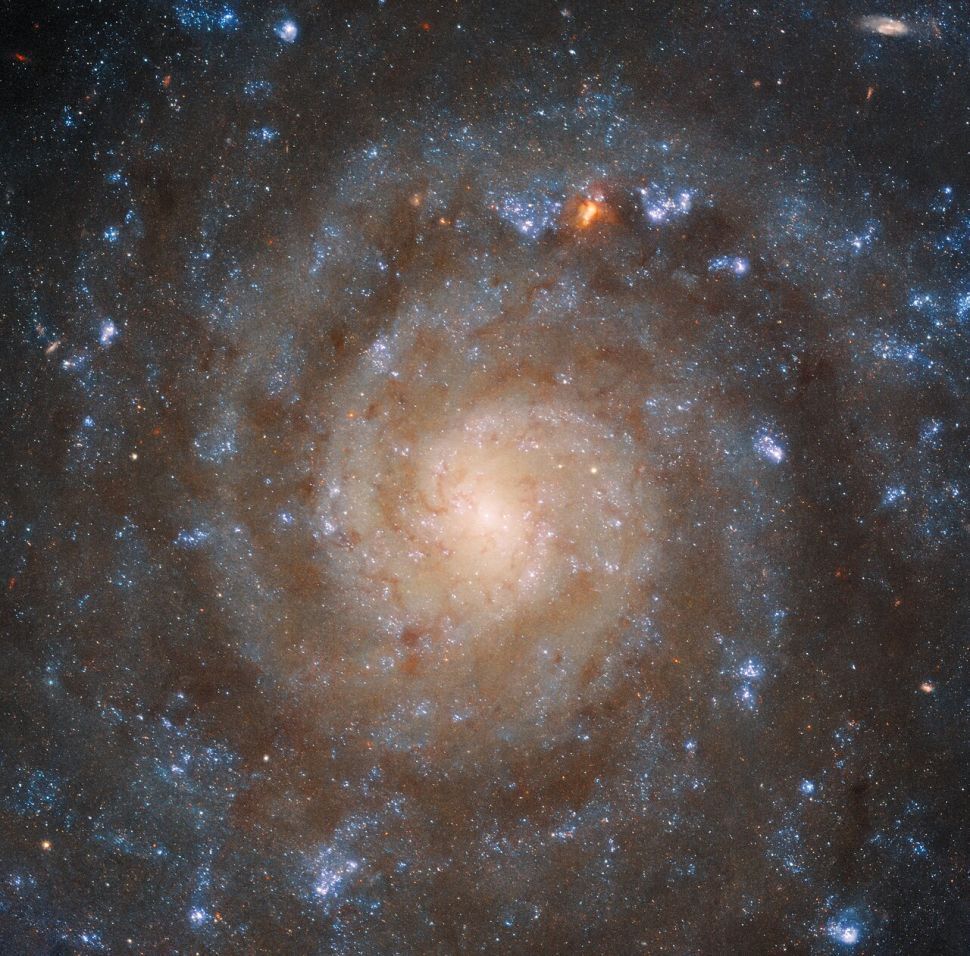
Hubble's image of IC 5332 shows the structure of some of the spiral arms obscured by clouds of dust. (Image credit: ESA/Webb, NASA & CSA, J. Lee and the PHANGS-JWST and PHANGS-HST Teams)
To snap this image, the JWST used its Mid-Infrared Instrument — a specialized camera that, in order to remove infrared interference effects from other heat sources, needs to be supercooled to minus 446.8 degrees Fahrenheit (minus 266 degrees Celsius). The JWST's location in the cold vastness of space, away from Earth, is also essential for helping it spot faint infrared light, as the heat of our planet would drown out the distant galaxy's signal.
About 100 times more powerful than the Hubble Space Telescope, the $10 billion space observatory was launched to a gravitationally stable location 1 million miles (1.5 million kilometers) from Earth — known as a Lagrange point — in December 2021. The JWST is the most advanced space telescope ever built, with the ability to peek inside the atmospheres of far-away exoplanets and read the earliest chapter of the universe's history in its faintest glimmers of light — which have been stretched to infrared frequencies from billions of years of travel across the expanding fabric of space-time(opens in new tab).
Six months of painstaking setup and calibration saw the telescope's instruments and its 21-foot-wide (6.5 meters) gold-plated mirror readied for operation. Following the unveiling of its first images in July, the telescope has been wowing with a steady stream of mindblowing snaps of our near and distant universe. To name just a few, the telescope has captured stunning images of cartwheel galaxies(opens in new tab); Einstein rings(opens in new tab); Orion's sword(opens in new tab); Neptune's ghostly halo(opens in new tab); and the deepest image of the universe ever produced(opens in new tab).
In the case of IC 5332, ESA scientists hope that by comparing the Hubble and JWST images of the distant galaxy, they can learn more about the galaxy’s composition and structure, as well as how these may translate to more general patterns witnessed across all spiral galaxies.
Quelle: SC
----
Update: 14.10.2022
.
NASA releases new images of 'fingerprint-like' dust rings from Webb telescope
Each ring was formed when the stars were nearby of one another.

The two stars in Wolf-Rayet 140 produce shells of dust every eight years that look like rings, as seen in this image from NASA’s James Webb Space Telescope. Each ring was created when the stars came close together and their stellar winds collided, compressing the gas and forming dust.
NASA on Wednesday, released a new image from the James Webb Space Telescope of dust rings, with a "fingerprint-like pattern," caused by two stars closely interacting with each other.
"We're looking at over a century of dust production from this system," Ryan Lau, an astronomer at NSF's NOIRLab, said in a news release about the discovery. "The image also illustrates just how sensitive this telescope is. Before, we were only able to see two dust rings, using ground-based telescopes. Now we see at least 17 of them."
According to NASA, each ring was formed when the stars were nearby of one another and the streams of gas they emitted met, creating dust.
"The stars' orbits bring them together about once every eight years; like the growth of rings of a tree's trunk, the dust loops mark the passage of time," NASA said in its announcement.
Lau said that the Webb telescope's mid-infrared technology could properly study the dust rings.
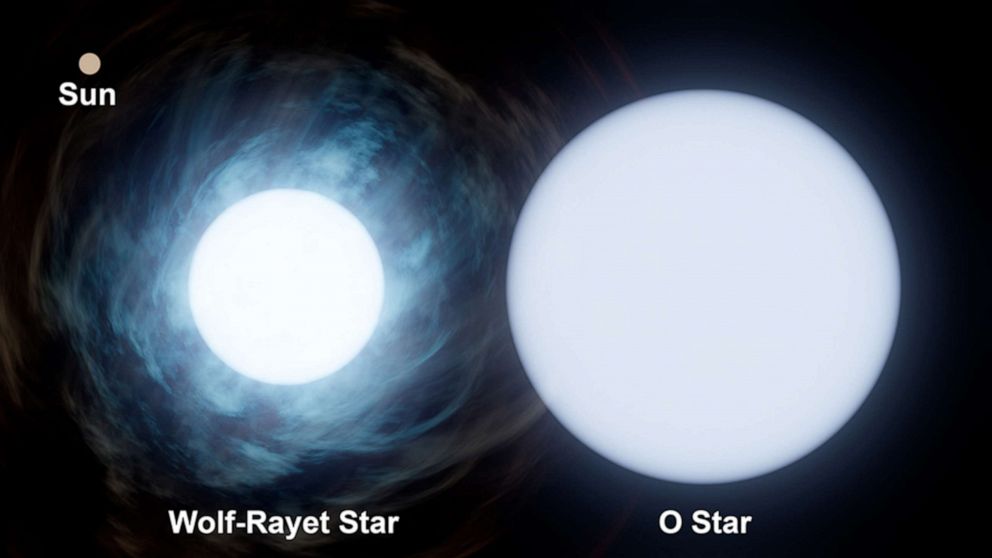
The telescope's near-infrared camera uses infrared radiation to detect objects in space.
It can observe celestial bodies, such as stars, nebulae and planets, that are too cool or too faint to be seen in visible light, or what is visible to the human eye.
Last month, the Webb telescope captured the clearest view of Neptune's rings in over 30 years.
"It has been three decades since we last saw these faint, dusty rings, and this is the first time we've seen them in the infrared," Heidi Hammel, an interdisciplinary scientist for the James Webb Telescope Project, said in a statement at the time.
In August, NASA released two images of Jupiter from Webb that highlighted the planet's features in detail.
Quelle: abcNews
+++
James Webb telescope solves dusty star mystery
It's one of the most striking images we've yet seen from the new super space telescope James Webb.
Many people were rather puzzled by it when it first popped up on social mediain late August, but astronomers in the know were delighted because of the insights they could draw.
The picture shows WR 140. It's a double star system, or a binary, some 5,000 light-years from Earth.
Those rings are dust shells that extend outwards over 10 trillion km.
That's a distance that's hard to comprehend. Put another way, it's 70,000 times the distance between Earth and our Sun.
"Previous observations of WR 140 revealed the presence of up to three shells. To see 17 like this is amazing, and shows the power of James Webb," said Dr Olivia Jones from the UK Astronomy Technology Centre (UK ATC) in Edinburgh which helped to build the telescope.
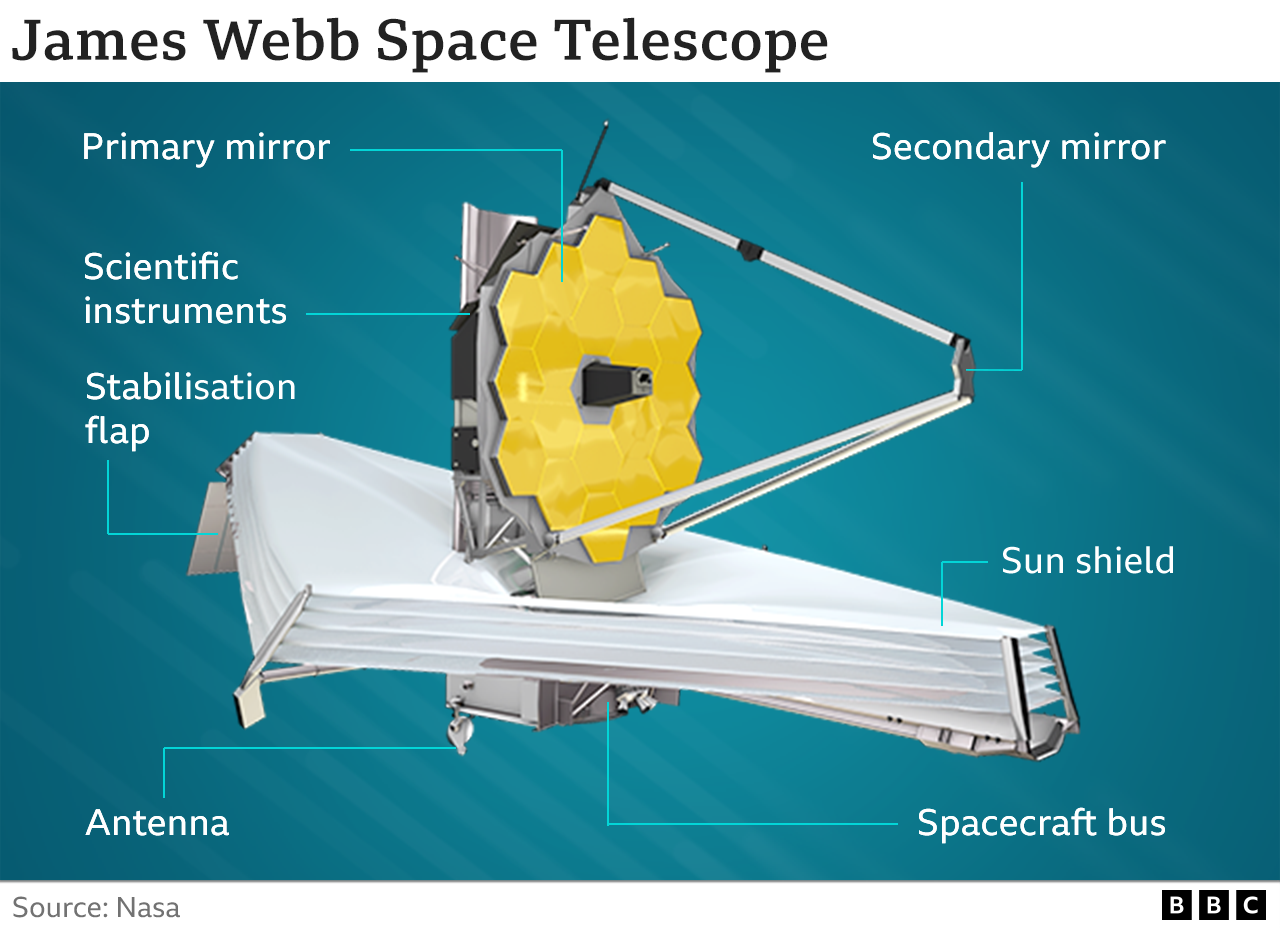
The WR in the name of the system refers to "Wolf-Rayet". It's a type of star. A big one that's reaching the end of its life.
Wolf-Rayets are unwieldy. They billow huge gaseous winds into space.
This one likely started out as big as its companion, an O-type star which is 30 times the mass of our Sun. The Wolf-Rayet, however, is probably now only 10 solar masses.
But it's the binary's properties and behaviour that explain the production of the dust shells. These are pumped out as the two objects come close together in their eight-year orbit around each other.
Their winds compress to create dust particles. Interestingly, this dust production is at its greatest when the two stars move towards and away from each other, not at closest approach.
This explains the slight unevenness in the bull's-eye pattern, but the angle at which Webb is viewing the scene also plays its part.
Astronomers are fascinated by how stable the shells are.
"We're looking at over a century of dust production from this system," said Dr Ryan Lau from the US National Science Foundation's NOIRLab and lead author on a new study about WR 140 published in the journal Nature Astronomy.
You can see why the time-dependent nature of the shells and their appearance lead people to make the analogy to tree rings.
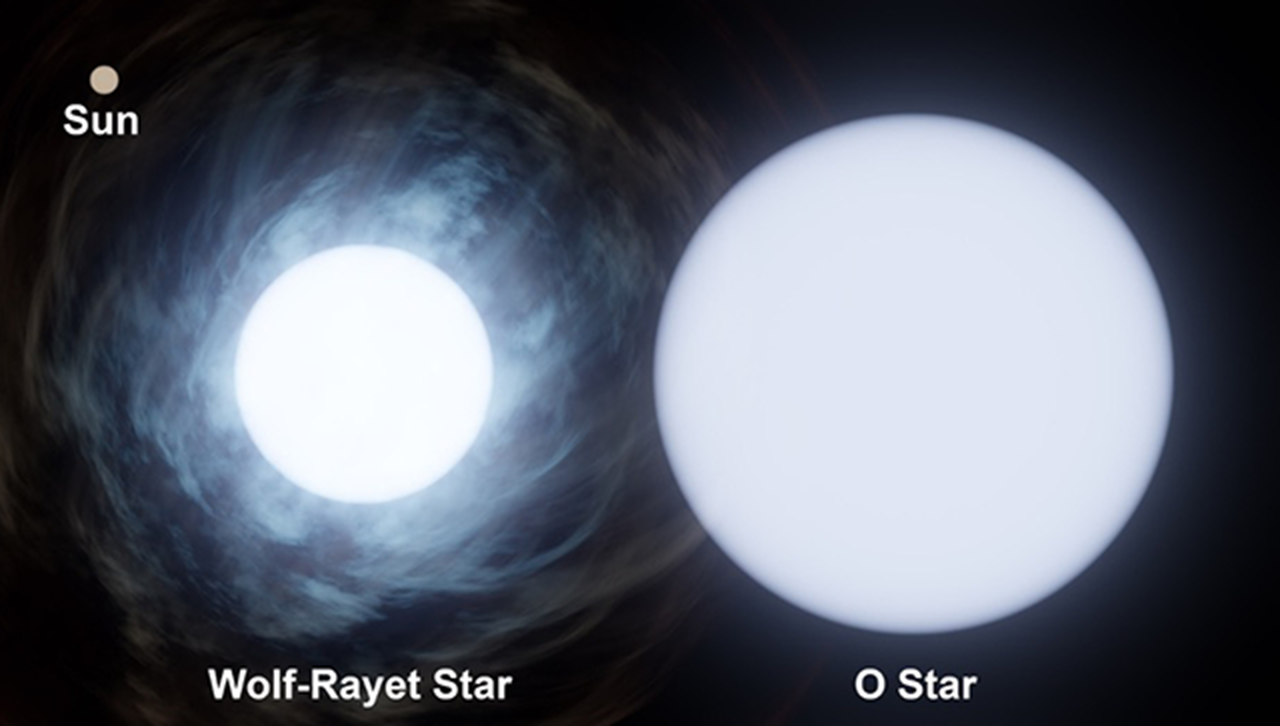
It was the UK ATC that led the design and construction - with the US space agency - of Webb's Mid Infrared Instrument, or Miri. And it's Miri that has not only taken the picture at the top of this page but also done the analysis of the light coming from the dust shells.
This has enabled scientists to determine their composition.
The shells are dominated by polycyclic aromatic hydrocarbons, PAHs. These are very carbon-rich compounds. You find them on burnt toast and in the exhaust from motor vehicles. PAHs produced by stars are thought to enrich the carbon content throughout the Universe.
In the initial Webb renderings of WR 140 that appeared on social media, eight very prominent spikes of light came off the central stars.
These were simply artifacts resulting from the telescope's segmented mirror system. Very bright objects in Webb pictures can have this "snowflake" effect.
For the image at the top of the page, the spikes have been removed to give a clearer view of the star system and its dust shells.
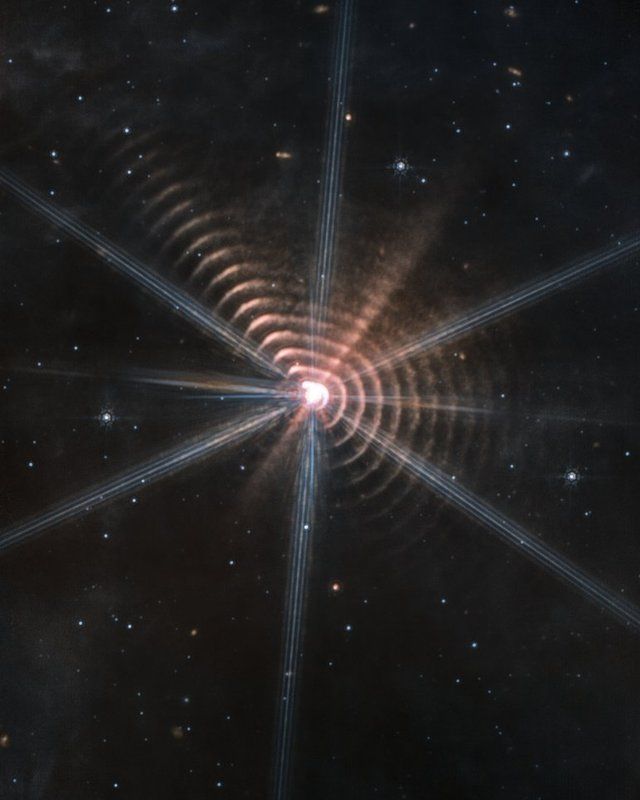
Quelle: BBC
----
Update: 19.10.2022
.
Strange molecules swirl around supermassive black holes, James Webb Space Telescope finds

A cluster of galaxies in Stephan's Quintet can be seen in deep space. (Image credit: NASA, ESA, CSA, and STScI)
NASA's iconic new observatory has spotted surprising compounds around supermassive black holes.
The James Webb Space Telescope (JWST) has detected carbon-bearing molecules called polycyclic aromatic hydrocarbons (PAHs) in the centers of three active galaxies, where scientists had expected these molecules couldn't survive. Intriguingly, the observations also suggest that the radiation in the vicinity of the supermassive black holes in these galaxies has altered the overall properties of the PAHs, which could complicate a key technique astronomers use to evaluate star formation, and could also affect their usefulness as biological building blocks.
Ismael García-Bernete, an astrophysicist at Oxford University in the U.K., led a group of astronomers who have analyzed observations of three active galaxies gathered by JWST's Mid-Infrared Instrument (MIRI). The three galaxies are NGC 6552, which is 370 million light-years away from Earth in the constellation Draco; NGC 7319, that is one of the five galaxies in the famous Stephan's Quintet some 311 million light-years away in Pegasus; and NGC 7469, which is also in Pegasus at a distance of about 200 million light-years.
PAHs are molecules characterized by rings of carbon atoms. These molecules are very common in the universe, found everywhere from distant galaxies to comets in our own solar system. Their ubiquity is what makes them useful potential building blocks for life, but it also makes them important tracers for star-formation. PAHs emit strongly at infrared wavelengths detectable by MIRI when they are illuminated by the ultraviolet radiation in starlight, so usually, where astronomers detect PAHs this way they can be sure there are hot, young stars nearby.
García-Bernete's aim was to determine whether PAH emission in the dense, ultraviolet-rich environment at the center of an active galaxy was the same as PAH emissions in calmer star-forming regions in the spiral arms of galaxies. While stars can form in the cores of active galaxies, the process of gas falling onto a supermassive black hole can also release torrents of ultraviolet light that cause the PAHs to glow.
Previous models had predicted that the harsh radiation around the supermassive black hole at the core of an active galaxy would actually destroy all PAH molecules. Instead, MIRI discovered that PAHs were plentiful in the central regions of all three galaxies studied. However, the observations showed that the emission was coming from larger and electrically neutral PAH molecules, indicating that radiation had indeed eradicated smaller, electrically charged PAHs. The larger PAH molecules may have survived because they were protected by dense, enveloping clouds of molecular gas, the team speculated.
The loss of the smaller, electrically charged PAHs is a problem for astronomers using these compounds to trace star formation, because star-forming regions are typically richer in electrically charged PAHs. But if these are destroyed in the cores of active galaxies, astronomers cannot track where stars might be forming.
"The next step is to analyze a larger sample of active galaxies with different properties," García-Bernete said in a statement. "This will enable us to better understand how PAH molecules survive and which are their specific properties in the nuclear region [of galaxies]. Such knowledge is key to using PAHs as an accurate tool for characterizing the amount of star formation in galaxies, and how galaxies evolve over time."
The research was published Sept. 30 in the journal Astronomy and Astrophysics.
Quelle: SC
----
Update: 24.10.2022
.
NASA’s Webb Telescope captures a fresh view of the famed star-forming region Pillars of Creation
As if the Pillars of Creation could get any more iconic.
NASA's James Webb Space Telescope has captured a fresh view of a famed celestial sight: the stunning star-forming region known as the Pillars of Creation.
The image, teeming with newborn stars and revealing new details of the region's haunting spires of dust and gas, was released Wednesday. It is the latest cosmic portrait from the Webb observatory, building on the telescope's already impressive collection.
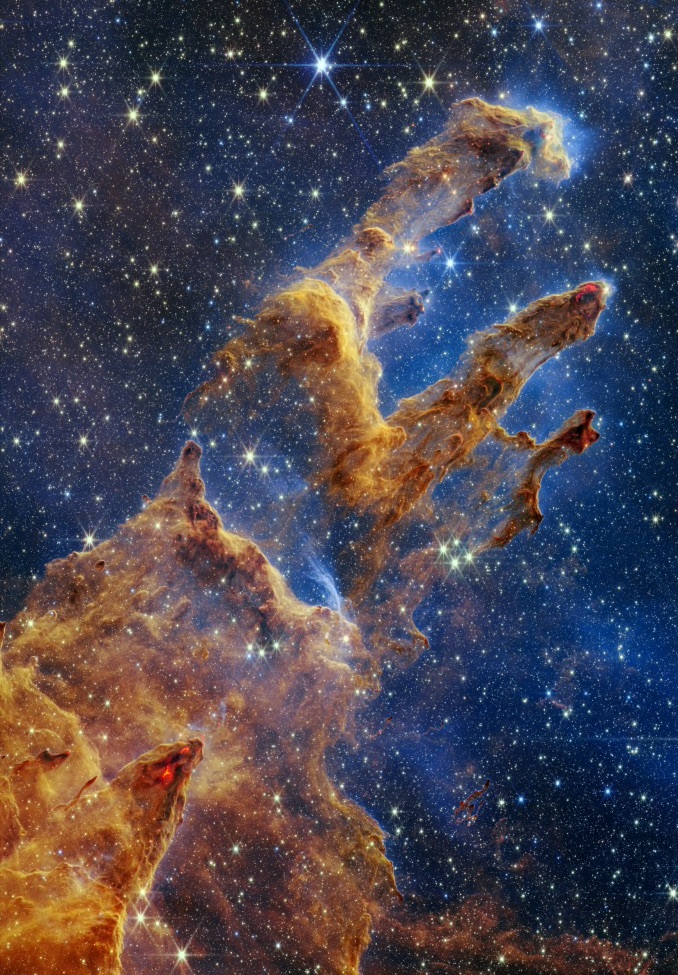
The Pillars of Creation are set off in a kaleidoscope of color in NASA’s James Webb Space Telescope’s near-infrared-light view. Space Telescope Science Institute Office of Public Outreach
David Grinspoon, an astrobiologist at the Planetary Science Institute, called the new Webb image “just spectacular beyond words.”
“Oh. My. Universe.” he tweeted.
The Pillars of Creation lie at the heart of a stellar nursery known as the Eagle Nebula, or Messier 16, which is located around 6,500 light-years away from Earth.
They form a familiar scene: the wispy towers of gas and dust, which resemble rock formations, were famously captured by the Hubble Space Telescope in 1995, then again in 2014. In the Webb observatory's new view, the sculpted columns appear less opaque, since Webb's infrared instruments can penetrate through some of the dust to reveal more of the region's newly formed stars.
Young stars, estimated to be only a few hundred thousand years old, are the bright red orbs in the image. New stars form within clouds of dust and gas as dense clumps of mass collapse under their own gravity and begin to heat up.
The Webb Telescope captured this dynamic journey in progress, according to Thomas Zurbuchen, the associate administrator of NASA's Science Mission Directorate.
"See those wavy lines that look like lava at the edges of the pillars? These are baby stars that are forming within the gas & dust," he tweeted.

The Pillars of Creation captured by the Hubble Space Telescope in 2014, left, and a new near-infrared-light view from the James Webb Space Telescope.Space Telescope Science Institute Office of Public Outreach
Observations from the Webb Telescope can help astronomers better understand the process of star formation and refine their models of how newborn stars emerge from clouds of interstellar gas, NASA said.
The tennis court-sized observatory is equipped with instruments that detect distant stars and galaxies in infrared and near-infrared light. This allows Webb to probe beyond the range of human sight and capture details that are invisible to other telescopes, including Hubble, that primarily detect visible light.
The $10 billion Webb observatory launched into space Dec. 25 last year. The first batch of images from the observatory was released in July, and these early science operations have already revealed tantalizing new details about the universe.
Quelle: NBC News
+++
NASA’s Webb Takes Star-Filled Portrait of Pillars of Creation
Editor's Note, Oct. 21, 2022: The story below has been updated to clarify what is visible in the in the James Webb Space Telescope's Pillars of Creation NIRCam image.
Lee esta historia en español aquí.
NASA’s James Webb Space Telescope has captured a lush, highly detailed landscape – the iconic Pillars of Creation – where new stars are forming within dense clouds of gas and dust. The three-dimensional pillars look like majestic rock formations, but are far more permeable. These columns are made up of cool interstellar gas and dust that appear – at times – semi-transparent in near-infrared light.
Webb’s new view of the Pillars of Creation, which were first made famous when imaged by NASA’s Hubble Space Telescope in 1995, will help researchers revamp their models of star formation by identifying far more precise counts of newly formed stars, along with the quantities of gas and dust in the region. Over time, they will begin to build a clearer understanding of how stars form and burst out of these dusty clouds over millions of years.
Newly formed stars are the scene-stealers in this image from Webb’s Near-Infrared Camera (NIRCam). These are the bright red orbs that typically have diffraction spikes and lie outside one of the dusty pillars. When knots with sufficient mass form within the pillars of gas and dust, they begin to collapse under their own gravity, slowly heat up, and eventually form new stars.
What about those wavy lines that look like lava at the edges of some pillars? These are ejections from stars that are still forming within the gas and dust. Young stars periodically shoot out supersonic jets that collide with clouds of material, like these thick pillars. This sometimes also results in bow shocks, which can form wavy patterns like a boat does as it moves through water. The crimson glow comes from the energetic hydrogen molecules that result from jets and shocks. This is evident in the second and third pillars from the top – the NIRCam image is practically pulsing with their activity. These young stars are estimated to be only a few hundred thousand years old.
Although it may appear that near-infrared light has allowed Webb to “pierce through” the clouds to reveal great cosmic distances beyond the pillars, there are almost no galaxies in this view. Instead, a mix of translucent gas and dust known as the interstellar medium in the densest part of our Milky Way galaxy’s disk blocks our view to much of the of the deeper universe.
This scene was first imaged by Hubble in 1995 and revisited in 2014, but many other observatories have also stared deeply at this region. Each advanced instrument offers researchers new details about this region, which is practically overflowing with stars.
This tightly cropped image is set within the vast Eagle Nebula, which lies 6,500 light-years away.
Download the full-resolution, uncompressed version and supporting visuals of Webb’s near-infrared image, the comparison of Hubble and Webb’s images, and the video tour of Webb’s image from the Space Telescope Science Institute.
The James Webb Space Telescope is the world's premier space science observatory. Webb will solve mysteries in our solar system, look beyond to distant worlds around other stars, and probe the mysterious structures and origins of our universe and our place in it. Webb is an international program led by NASA with its partners, ESA (European Space Agency) and CSA (Canadian Space Agency).
Quelle: NASA


